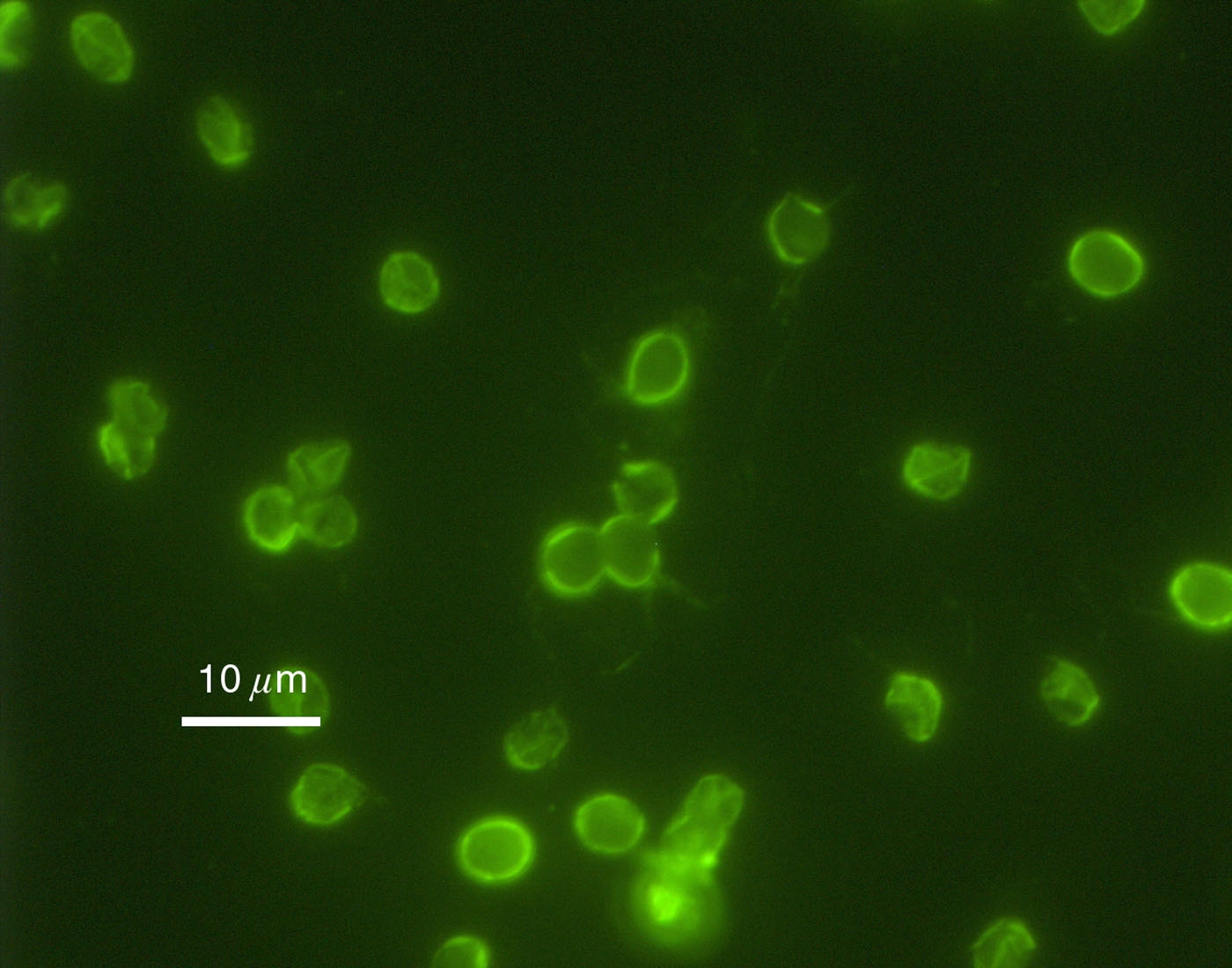Cryptosporidium parvum: Difference between revisions
No edit summary |
No edit summary |
||
| Line 49: | Line 49: | ||
:::* Note: Nitazoxanide is not licensed for immunodeficient patients | :::* Note: Nitazoxanide is not licensed for immunodeficient patients | ||
==References== | |||
{{reflist|2}} | |||
[[es:Cryptosporidium parvum]] | [[es:Cryptosporidium parvum]] | ||
Revision as of 17:22, 3 August 2015
| Cryptosporidium parvum | ||||||||||||||||
|---|---|---|---|---|---|---|---|---|---|---|---|---|---|---|---|---|
 Immunofluorescence image of C. parvum oocysts.
| ||||||||||||||||
| Scientific classification | ||||||||||||||||
| ||||||||||||||||
| Binomial name | ||||||||||||||||
| Cryptosporidium parvum |
Cryptosporidium parvum is one of several species that cause cryptosporidiosis.
Cryptosporidium parvum is a protozoal infection which causes an acute, watery, and non-bloody diarrhoea in immunocompromised patients.
In HIV infection, it can cause a watery diarrhoea which may be associated with anorexia, nausea/vomiting and also abdominal pain.
The sporozoa is contracted by fecal-oral route. The oocyst (which is the infective form of the organism) enters the GI tract and transform to sporozoites (a later form of C.Parvum). Furthermore, these sporozoites differentiate into trophozoites and attach to intestinal epithelium. This leads to malabsorbtion, and a watery, non-bloody diarrhea that is limited in immunecompetent people.
Later, the organism undergoes additional transformation phases: trophozoite-->type I meront-->merozoite-->type II meront-->merozoite--> Undifferentiated Gamont--> Micro/Macro-Gamont-->zygote-->oocyst. The cycle is completed when oocysts are excreted with the stools contaminating water, food, hands, and are ingested by either humans or other animals.
In immunecompromised patients, such as those with AIDS or those undergoing immunosuppressive therapy, the diarrhea might not be self limited, and can lead to dehydration and if untreated - death.
The diagnosis of C.Parvum consists of serological tests and microscopic evaluation of oocysts in stools using Kinyoun acid-fast staining.
There is no effective treatment (other than supportive treatment) for this infection apart from an antibiotic called Paromomycin. This drug may have a limited effect on the diarrhea.
Cryptosporidium parvum is considered to be the most important water-bourne pathogen in developed countries. It is resistant to all practical levels of chlorination, it can survive for 24hrs at 1000mg/L free chlorine.
Treatment
Antimicrobial Regimen
- Cryptosporidium parvum
Return to Top
- 1. Immunocompetent[1]
- Preferred regimen: No specific therapy recommended since healthy patients usually recover within a few weeks, but if needed: Nitazoxanide 500 mg PO bid for 3 days.
- 2. HIV[2]
- Preferred regimen: Nitazoxanide 500 mg PO bid for 3 days
- 3. HIV and Immunodeficiency[3]
- Preferred regimen: Effective antiretroviral therapy
- Note: Nitazoxanide is not licensed for immunodeficient patients
References
- ↑ Rossignol JF, Ayoub A, Ayers MS (2001). "Treatment of diarrhea caused by Cryptosporidium parvum: a prospective randomized, double-blind, placebo-controlled study of Nitazoxanide". J Infect Dis. 184 (1): 103–6. doi:10.1086/321008. PMID 11398117.
- ↑ Gilbert, David (2015). The Sanford guide to antimicrobial therapy. Sperryville, Va: Antimicrobial Therapy. ISBN 978-1930808843.
- ↑ Gilbert, David (2015). The Sanford guide to antimicrobial therapy. Sperryville, Va: Antimicrobial Therapy. ISBN 978-1930808843.